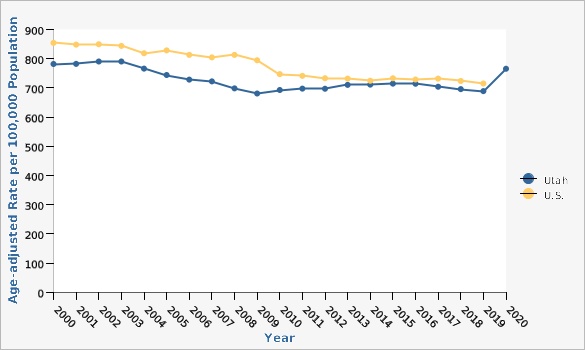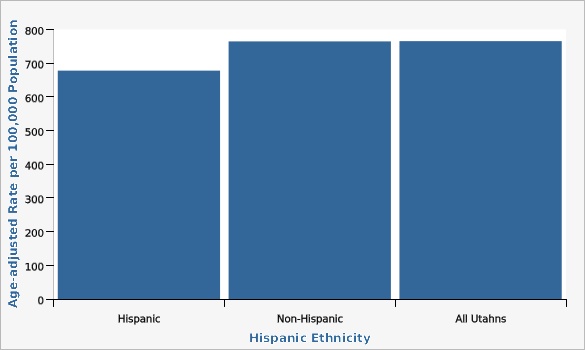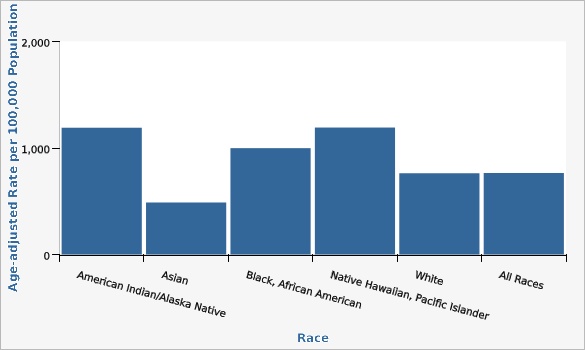Complete Health Indicator Report of Deaths From All Causes
Definition
Number of deaths per 100,000 persons.Numerator
Number of deaths.Denominator
Number of persons in population.Data Interpretation Issues
Age-adjusted to U.S. 2000 standard population using 10 age groups.Why Is This Important?
The death rates are important indicators of the quality of public health service in particular populations.How Are We Doing?
Mortality monitoring is an important and useful measure to public health authorities. In Utah, by statute, death records must be registered within five calendar days.How Do We Compare With the U.S.?
Utah has experienced lower age-adjusted death rates than the U.S. It is interesting to see the gap in death rates between the U.S. and Utah decrease through the years. Factors that contributed to lower death rates in Utah over the past 25 years include healthy lifestyles (especially low rates of tobacco, alcohol, and substance use), lower rates of poverty, and better access to health care. A decrease in death rates across the state comes with certain implications, including increased economic demands on health care systems, including strain on aging services, long-term health care, and assisted living facilities.What Is Being Done?
The UDOH Office of Vital Records and Statistics certifies Utah deaths and maintains records of specific characteristics such as cause of death, age of decedent, and other factors associated, such as firearm, motor vehicle, or drug overdose incidents.Related Indicators
Relevant Population Characteristics
Improvements in life expectancy increase the proportion of older individuals living in society. Policy-makers must be aware of this trend in order to provide viable and attractive options for elderly persons who require assistance with activities of daily living.Related Relevant Population Characteristics Indicators:
Health Care System Factors
Advances in medical technology are one of the factors lowering death rates in Utah and elsewhere. One issue with extending lives through medical technology is that individuals often have chronic disabilities that have implications for their quality of life. Health expenditures for providing end-of-life care are disproportionately high. The difficult moral and ethical issues involved in provision of end-of-life care should be considered by all individuals, and their wishes made known to family members who would be likely to make health care decisions in the event of their incapacity.Related Health Care System Factors Indicators:
Risk Factors
It is a given that we all must die. The best we can hope for is to be healthy and active until death, and that our deaths be painless, graceful, and quick. Healthy lifestyles and early detection of disease lead to both longer life and improved quality of life across the lifespan.Related Risk Factors Indicators:
- Daily Fruit Consumption
- Daily Vegetable Consumption
- Alcohol Consumption - Binge Drinking
- Blood Cholesterol Screening
- Breast Cancer Screening (Mammography)
- Cervical Cancer Screening (Pap)
- Smoking Among Adults
- Smoking Among Adolescents
- Colorectal Cancer Screening
- Diabetes Hemoglobin A1C Tests
- Immunizations - Recommended Immunizations by Age 24 Months
- Immunization - Influenza, Adults
- Immunizations - Pneumonia, Adults
- Newborn Hearing Screening
- Newborn Heelstick Screening
- Obesity Among Adults
- Obesity Among Children and Adolescents
- Overweight or Obese
- Physical Activity: Recommended Aerobic Activity Among Adults
- Physical Activity Among Adolescents
- Physical Activity: Recommended Muscle-strengthening Among Adults
- Personal doctor or health care provider
- Prostate Cancer Screening
- Routine Dental Health Care Visits
- Routine medical care visits
- Seat Belts: Safety Restraint Use
- Sun Safety Measures
Health Status Outcomes
The leading causes of death (heart disease, cancer, and stroke) are much the same for Utah and the rest of the U.S., regardless of sex, race, or ethnicity.Related Health Status Outcomes Indicators:
- Breast Cancer Deaths
- Birth Defects: Infant Mortality
- Cancer Deaths
- Carbon Monoxide Deaths
- Cervical Cancer Death
- Colorectal Cancer Deaths
- Deaths due to Diabetes as Underlying Cause
- Homicide
- Ischemic Heart Disease Deaths
- Infant Mortality
- Life Expectancy at Birth
- Lung Cancer Deaths
- Maternal Mortality
- Melanoma of the Skin Deaths
- Motor Vehicle Traffic Crash Deaths
- Drug Overdose and Poisoning Incidents
- Prostate Cancer Deaths
- Stroke (Cerebrovascular Disease) Deaths
- Suicide
- Unintentional Injury Deaths
Graphical Data Views
| Utah vs. U.S. | Year | Age-adjusted Rate per 100,000 Population | Lower Limit | Upper Limit | Numer- ator | Denom- inator |
|---|---|---|---|---|---|---|
Record Count: 41 | ||||||
| Utah | 2000 | 781.7 | 767.9 | 795.8 | 12,335 | 2,244,502 |
| Utah | 2001 | 782.4 | 768.6 | 796.3 | 12,605 | 2,283,715 |
| Utah | 2002 | 790.2 | 776.6 | 804.0 | 13,041 | 2,324,815 |
| Utah | 2003 | 790.2 | 776.7 | 803.9 | 13,339 | 2,360,137 |
| Utah | 2004 | 765.8 | 752.7 | 779.1 | 13,268 | 2,401,580 |
| Utah | 2005 | 744.1 | 731.4 | 757.0 | 13,324 | 2,457,719 |
| Utah | 2006 | 728.3 | 716.0 | 740.8 | 13,642 | 2,525,507 |
| Utah | 2007 | 722.3 | 710.2 | 734.5 | 13,987 | 2,597,746 |
| Utah | 2008 | 698.3 | 686.6 | 710.1 | 13,920 | 2,663,029 |
| Utah | 2009 | 680.7 | 669.3 | 692.2 | 14,010 | 2,723,421 |
| Utah | 2010 | 692.6 | 681.2 | 704.0 | 14,645 | 2,775,413 |
| Utah | 2011 | 697.5 | 686.3 | 708.9 | 15,155 | 2,814,797 |
| Utah | 2012 | 697.1 | 686.0 | 708.3 | 15,523 | 2,854,146 |
| Utah | 2013 | 710.2 | 699.2 | 721.4 | 16,243 | 2,898,773 |
| Utah | 2014 | 711.1 | 700.2 | 722.1 | 16,652 | 2,938,327 |
| Utah | 2015 | 714.4 | 703.6 | 725.3 | 17,260 | 2,983,626 |
| Utah | 2016 | 714.1 | 703.5 | 724.8 | 17,811 | 3,044,241 |
| Utah | 2017 | 704.0 | 693.6 | 714.5 | 18,039 | 3,103,540 |
| Utah | 2018 | 695.8 | 685.7 | 706.1 | 18,366 | 3,155,153 |
| Utah | 2019 | 688.9 | 679.0 | 699.0 | 18,744 | 3,203,383 |
| Utah | 2020 | 765.4 | 755.1 | 775.9 | 21,500 | 3,249,879 |
| U.S. | 2000 | 854.0 | ||||
| U.S. | 2001 | 848.0 | ||||
| U.S. | 2002 | 849.5 | ||||
| U.S. | 2003 | 843.9 | ||||
| U.S. | 2004 | 818.8 | ||||
| U.S. | 2005 | 828.4 | ||||
| U.S. | 2006 | 813.1 | ||||
| U.S. | 2007 | 804.6 | ||||
| U.S. | 2008 | 812.9 | ||||
| U.S. | 2009 | 794.5 | ||||
| U.S. | 2010 | 747.0 | ||||
| U.S. | 2011 | 741.3 | ||||
| U.S. | 2012 | 732.8 | ||||
| U.S. | 2013 | 731.9 | ||||
| U.S. | 2014 | 724.6 | ||||
| U.S. | 2015 | 733.1 | ||||
| U.S. | 2016 | 728.8 | ||||
| U.S. | 2017 | 731.9 | ||||
| U.S. | 2018 | 723.6 | ||||
| U.S. | 2019 | 715.2 | ||||
Data Notes
Age-adjusted to U.S. 2010 standard population. Rates are age-adjusted to the 2000 U.S. standard population using 3 age groups, 0-44, 45-64, and 65+.Data Sources
- Utah Death Certificate Database, Office of Vital Records and Statistics, Utah Department of Health
- Population Estimates: National Center for Health Statistics (NCHS) through a collaborative agreement with the U.S. Census Bureau, IBIS Version 2018
- U.S. Underlying Cause of Death Data: WONDER Online Database. Centers for Disease Control and Prevention, National Center for Health Statistics. Accessed at [http://wonder.cdc.gov/ucd-icd10.html]
- National Vital Statistics System, National Center for Health Statistics, U.S. Centers for Disease Control and Prevention
The death rate for Hispanic Utahns was significantly lower than for all Utahns.
| Hispanic Ethnicity | Age-adjusted Rate per 100,000 Population | Lower Limit | Upper Limit | |||
|---|---|---|---|---|---|---|
Record Count: 3 | ||||||
| Hispanic | 677.9 | 640.1 | 717.4 | |||
| Non-Hispanic | 764.7 | 754.0 | 775.5 | |||
| All Utahns | 765.4 | 755.1 | 775.9 | |||
Data Notes
Rates are age-adjusted to the 2000 U.S. standard population using 10 age groups.Data Sources
- Utah Death Certificate Database, Office of Vital Records and Statistics, Utah Department of Health
- Population Estimates by Age, Sex, Race, and Hispanic Origin for Counties in Utah, U.S. Bureau of the Census, IBIS Version 2018
The death rate for Asian Utahns was significantly lower than for all Utahns.
| Race | Age-adjusted Rate per 100,000 Population | Lower Limit | Upper Limit | |||
|---|---|---|---|---|---|---|
Record Count: 6 | ||||||
| American Indian/Alaska Native | 1,190.4 | 1,046.9 | 1,348.0 | |||
| Asian | 488.3 | 432.6 | 549.3 | |||
| Black, African American | 998.6 | 839.1 | 1,179.5 | |||
| Native Hawaiian, Pacific Islander | 1,192.1 | 1,046.8 | 1,352.0 | |||
| White | 762.9 | 751.9 | 774.0 | |||
| All Races | 765.4 | 755.1 | 775.9 | |||
Data Notes
Race is non-Hispanic and Ethnicity includes any race. Rates are age-adjusted to the 2000 U.S. standard population using 10 age groups.Data Sources
- Utah Death Certificate Database, Office of Vital Records and Statistics, Utah Department of Health
- Population Estimates by Age, Sex, Race, and Hispanic Origin for Counties in Utah, U.S. Bureau of the Census, IBIS Version 2018
References and Community Resources
Jiaquan Xu, M.D., et al. Deaths: Final Data for 2019. National vital statistics reports: vol 70 no 8. Hyattsville, MD: National Center for Health Statistics, July 2021. [https://www.cdc.gov/nchs/data/nvsr/nvsr70/nvsr70-08-508.pdf]More Resources and Links
Evidence-based community health improvement ideas and interventions may be found at the following sites:- Centers for Disease Control and Prevention (CDC) WONDER Database, a system for disseminating public health data and information.
- United States Census Bureau data dashboard.
- Utah healthy Places Index, evidence-based and peer-reviewed tool, supports efforts to prioritize equitable community investments, develop critical programs and policies across the state, and much more.
- County Health Rankings
- Kaiser Family Foundation's StateHealthFacts.org
- Medical literature can be queried at PubMed library.
Page Content Updated On 03/24/2022,
Published on 11/14/2022



